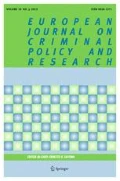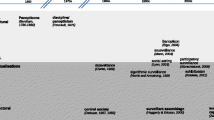Abstract
This paper describes the latest stage of an ongoing attempt to update and upgrade CPTED’s concepts and actions and link them more closely to developments in architecture, design and crime science. The concept of territoriality, for example, is central to the practice domain of CPTED. Yet territoriality is only vaguely defined within that domain, as are the other core concepts such as activity support and target hardening; and all of them confusingly intersect and overlap. The paper attempts a remedy by developing a suite of definitions in depth, relating the core concepts to various frameworks and discourses developed for crime prevention and design against crime, and more generally exploring ways in which CPTED could become richer and more subtle. It will also consider the ‘dark side’ of the environment, covering offenders’ countermoves to prevention and their own counter-exploitation of space, buildings and what they contain. The ultimate intention is to produce a more rigorous, yet deeper and better-integrated conception of CPTED useful for practice, research and theory alike. The paper should be considered as work in progress, indicating what might be possible and stimulating debate rather than offering a definitive resolution of the issue. Further steps are suggested and constructive contributions from readers are invited.
Similar content being viewed by others
Notes
See, e.g. www.controlledvocabulary.com.
Various attempts to define crime prevention are discussed in Ekblom, 2011.
An enclosed area occupied by a dwelling, grounds, and outbuildings.
See Wortley (1996) for a wider situational interpretation of ‘soft’ interventions.
It’s unfortunate that the English language confuses property meaning ‘owned goods’ with that meaning ‘owned places’ and also ‘certain capacities to cause’ – though where interpretation is ambiguous, the last can be indicated by adding the qualifier ‘causal’.
Note that, in the body of the text of Ekblom and Sidebottom (2007), ‘features’ was given a meaning which is here referred to as ‘properties’. The change of meaning was referred to in the end notes of that article, but came too late to revise the entire document. Such are the perils of terminological development.
See Loqvist’s concept design for a ‘No ClimBIN’ at www.designoutcrime.org.
For a discussion of assimilation versus accommodation of terms and concepts in crime prevention see Ekblom 2011.
Battering rams used in police raids create a pleasing symmetry.
From the CLAIMED framework for mobilising preventers – Ekblom 2011.
References
Alexander, C., Ishikawa, S., & Silverstein, M. (1977). A Pattern Language. Oxford: Oxford University Press.
Appleton, J. (1975). The experience of place. London: Wiley.
Ardrey, R. (1966). The territorial imperative: a personal inquiry into the animal origins of property and nations. New York: Atheneum.
Armitage, R. (2000). An evaluation of secured by design housing in West Yorkshire. Policing and reducing crime unit briefing note 7/00. London: Home Office.
Armitage, R. (2007). Sustainability versus safety: Confusion, conflict and contradiction in designing out crime. In G. Farrell, K. Bowers, S. Johnson, & M. Townsley (Eds.), Imagination for crime prevention: Essays in honour of Ken Pease. Crime prevention studies 21 (pp. 81–110). Cullompton: Willan.
Atlas, R. (1991). The other side of defensible space. Security Management, March, 63–66.
Barker, R. (1968). Ecological psychology. Concepts and methods for studying the environment of human behavior. Stanford: Stanford University Press.
Brantingham, P., & Brantingham, P. (2008). Crime pattern theory. In R. Wortley & L. Mazerolle (Eds.), Environmental criminology and crime analysis. Cullompton: Willan.
Brantingham, P., & Faust, F. (1976). A conceptual model of crime prevention. Crime and Delinquency, 22, 130–146.
BSRIA (2010). Website www.bsria.co.uk/services/design/soft-landings/ accessed 24 October 2010. London: The Building Services Research and Information Association.
CABE (2010). Post-occupancy evaluation. Website www.cabe.org.uk/sustainable-places/advice/post-occupancy-evaluation accessed 24 October 2010. London: Commission for Architecture and the Built Environment.
Clarke, R., & Eck, J. (2003). Become a problem solving crime analyst in 55 small steps. London: Jill Dando Institute, University College London.
Clarke, R., & Newman, G. (2006). Outsmarting the Terrorists. London: Praeger Security International.
Cornish, D. (1994). The procedural analysis of offending and its relevance for situational prevention. In R. Clarke (Ed.), Crime prevention studies, 3 (pp. 151–196). Monsey: Criminal Justice Press.
Cozens, P., Saville, G., & Hillier, D. (2005). Crime Prevention Through Environmental Design (CPTED): a review and modern bibliography. Property Management, 23, 328–356.
Cropley, D., Cropley, A., Kaufman, J., & Runco, M. (2010). The dark side of creativity. Cambridge: Cambridge University Press.
Crowe, T. (2000). Crime prevention through environmental design: Applications of architectural design and space management concepts (2nd ed.). Oxford: Butterworth-Heinemann.
DCLG. (2004). Safer places: The planning system and crime prevention. London: Department for Communities and Local Government.
Ekblom, P. (2002). From the source to the mainstream is uphill: The challenge of transferring knowledge of crime prevention through replication, innovation and anticipation. In N. Tilley (Ed.), Analysis for Crime Prevention, Crime Prevention Studies 13 (pp. 131–203). Cullompton: Willan Publishing.
Ekblom, P. (2004a). Shared responsibilities, pooled resources: A partnership approach to crime prevention. In P. Ekblom & A. Wyvekens (Eds.), A partnership approach to crime prevention. Strasbourg: Council of Europe Publishing.
Ekblom, P. (2004b). Reconciling evidence of what works, knowledge of crime reduction and community safety principles, and values. Annex 2 of Safer Places: The planning system and crime prevention. London: Department for Communities and Local Government.
Ekblom, P. (2005a). Designing products against crime. In N. Tilley (Ed.), Handbook of crime prevention and community safety (pp. 203–244). Cullompton: Willan.
Ekblom, P. (2005b). How to police the future: Scanning for scientific and technological innovations which generate potential threats and opportunities in crime, policing and crime reduction. In M. Smith & N. Tilley (Eds.), Crime science: New approaches to preventing and detecting crime. Cullompton: Willan.
Ekblom, P. (2010a). How to understand, specify and describe the security function of a product: Towards a language and a framework for designing against crime’, International Seminar on Environmental Criminology and Crime Analysis (ECCA), Brisbane. Available at www.designagainstcrime.com > archive > lectures and presentations.
Ekblom, P. (2010b). The Conjunction of Criminal Opportunity theory. Sage Encyclopedia of Victimology and Crime Prevention.
Ekblom, P. (2011). Crime prevention, security and community safety using the 5Is framework. Basingstoke: Palgrave Macmillan.
Ekblom, P., & Sidebottom, A. (2007). What do you mean, ‘Is it secure?’ Redesigning language to be fit for the task of assessing the security of domestic and personal electronic goods. European Journal on Criminal Policy and Research, 14, 61–87.
Felson, M. (1986). Linking criminal choices, routine activities, informal control, and criminal outcomes. In D. Cornish & R. Clarke (Eds.), The Reasoning Criminal (pp. 119–128). New York: Springer-Verlag.
Felson, M. (2003). The process of co-offending. In M. Smith & D. Cornish (Eds.), Theory for practice in situational crime prevention, Crime Prevention Studies 16. Cullompton: Willan.
Fisher, B., & Nasar, J. (1992). Fear of crime in relation to three exterior site features: prospect, refuge, and escape. Environment and Behavior, 24, 35–65.
Gamman, L. & Pascoe, T. (Eds) (2004). Seeing is believing, special issue of Crime Prevention and Community Safety Journal, 6/4.
Gamman, L. & Raein, M. (2000). Reviewing the art of crime: What, if anything, do criminals and artists/designers have in common? In: D. Cropley, A. Cropley, J. Kaufman and M. Runco (2010). The Dark Side of Creativity. Cambridge: Cambridge University Press.
Jacobs, J. (1961). The death and life of great American cities. New York: Random House.
Jeffery, C. R. (1971). Crime prevention through environmental design. Beverly Hills: Sage Publications. revised 1977.
Jongejans, A. (2010). The Dutch ‘Police label secure housing’: A successful approach. Internal Security, 147–170. Szczytno, Poland: Higher Police School. http://internalsecurity.wspol.eu/free-sample/the-dutch-police-label-secure-housing-a-successful-approach
Kintrea, K., Bannister, J., Pickering, J., Reid, M., & Suzuki, N. (2008). ‘It's an area – we all represent it': Young people and territoriality in British cities. York: Joseph Rowntree Foundation.
Merry, S. (1981). Defensible space undefended: social factors in crime prevention through environmental design. Urban Affairs Quarterly, 16, 397–422.
Newman, O. (1972). Defensible space: Crime prevention through urban design. New York: Macmillan.
Painter, K., & Farrington, D. (1997). The crime reducing effect of improved lighting: The Dudley project. In R. Clarke (Ed.), Situational Crime Prevention: Successful Case Studies (2nd ed.). Guilderland, NY: Harrow and Heston.
Pawson, R. (2006). Evidence-based policy. A realist perspective. London: Sage.
Pawson, R., & Tilley, N. (1997). Realistic evaluation. London: Sage.
Poyner, B. (1983). Designing against crime: Beyond defensible space. London: Butterworths.
Roach, J., Ekblom, P., & Flynn, R. (2005). The Conjunction of Terrorist Opportunity: a framework for diagnosing and preventing acts of terrorism. Security Journal, 18, 7–25.
Saville, G., & Cleveland, G. (2003a). An introduction to 2nd Generation CPTED: Part 1. CPTED Perspectives, 6(1), 7–9.
Saville, G., & Cleveland, G. (2003b). An introduction to 2nd Generation CPTED: Part 2. CPTED Perspectives, 6(2), 4–8.
Sommer, R. (1969). Personal space. The behavioral basis of design. Englewood Cliffs: Prentice-Hall.
Tilley, N. (1993). After Kirkholt: Theory, methods and results of replication evaluations. Crime Prevention Unit Paper 47. London: Home Office.
Whitehead, S., Mailley, J., Storer, I., McCardle, J., Torrens, G., & Farrell, G. (2008). IN SAFE HANDS: a review of mobile phone anti-theft designs. European Journal on Criminal Policy and Research, 14, 39–60.
Wilson, J., & Kelling, G. (1982). Broken windows. The police and neighbourhood safety. The Atlantic Monthly, 3(2), 29–38.
Wortley, R. (1996). Guilt, shame and situational crime prevention. Crime Prevention Studies, 5, 115–132.
Wortley, R. (2008). Situational precipitators of crime. In R. Wortley & L. Mazerolle (Eds.), Environmental criminology and crime analysis. Cullompton: Willan.
Wortley, R., & McFarlane, M. (2010). The role of territoriality in crime prevention: A field experiment. Security Journal.
Acknowledgements
A version of this paper was first presented at the Crimprev workshop on Urban Criminology, Keele University, April 2009; I am grateful for EU 6th framework funding and invitation to attend by the organisers, Tim Hope and Guenter Stummvoll.
Author information
Authors and Affiliations
Corresponding author
Rights and permissions
About this article
Cite this article
Ekblom, P. Deconstructing CPTED… and Reconstructing it for Practice, Knowledge Management and Research. Eur J Crim Policy Res 17, 7–28 (2011). https://doi.org/10.1007/s10610-010-9132-9
Published:
Issue Date:
DOI: https://doi.org/10.1007/s10610-010-9132-9




